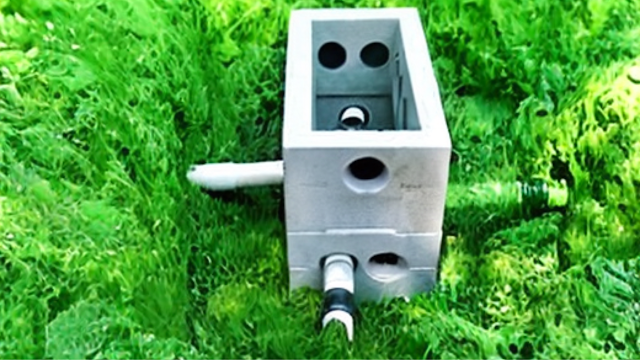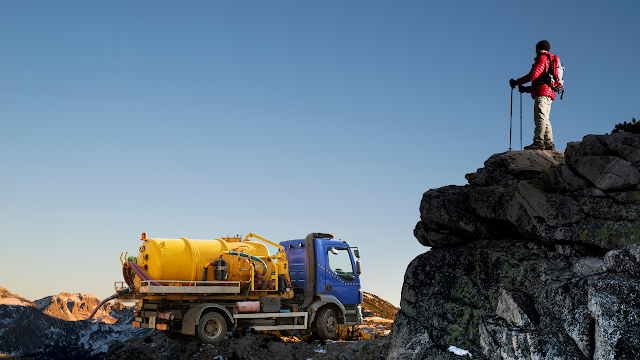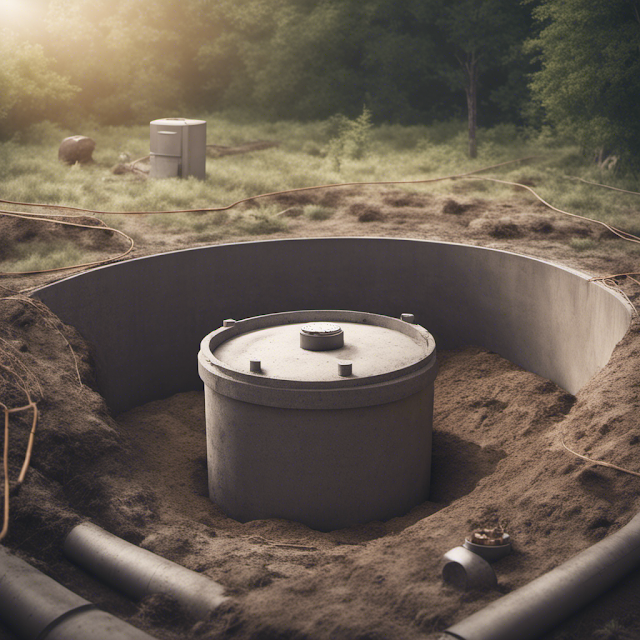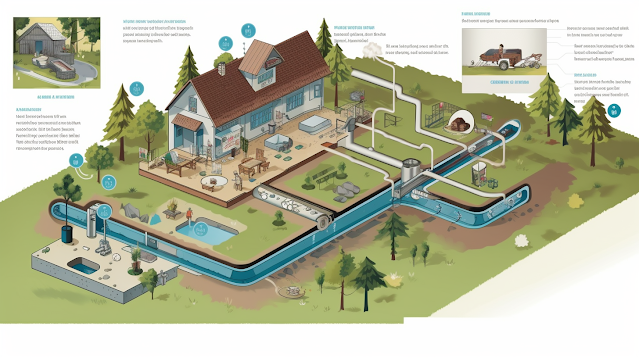Can you Drive Over a Septic Tank or Build Over It ?
 |
| can you drive over a septic tank ? |
Can you Drive Over a Septic Tank before you do read all this article as your septic system is the heart of your property, silently working to remove waste and keep your home clean and safe.
But did you know that driving or building over it can cause serious damage?
In this article, we will explore the potential risks and consequences of driving and building over your septic system.
By following the guidelines and solutions we provide, you can protect your septic system and avoid expensive and potentially hazardous problems.
So let's dive in or drive in but not over, and learn how to safeguard your septic system for years to come. If you do not then the costs to rectify can be staggering. Let me as someone with over 40 years of experience in the Septic tank Industry explain some of the consequences.
Key Takeaways
- Driving or parking over a septic tank can cause damage to the tank and lid, even with lightweight vehicles.
- Building permanent structures over the septic tank is not recommended as it can impair its function and pose health risks.
- Driving or parking on the septic drain field can lead to soil compaction, bacterial growth, and system failure.
- Damaging the septic tank or drain field can result in expensive repairs and contamination risks.
Potential Damage to Septic Tanks From Driving
Driving over your septic tank can cause damage, even if you have a lightweight vehicle like a compact car. The impact of heavy vehicles on septic tanks is a serious concern.
The potential damage to septic tank lids is particularly worrisome. Septic tank lids are not designed to withstand heavy loads, and the weight of a vehicle can cause them to crack or even collapse. This can lead to sewage leaks, contamination, and expensive repairs.
To avoid such issues, it is crucial to refrain from driving or parking on your septic tank. Instead, ensure that the lid is properly secured and accessible for regular maintenance and inspections.
Impact of Lightweight Vehicles on Septic Tank Health
To maintain the health of your septic tank, it's important to be aware that even lightweight vehicles can cause damage. Septic tanks are designed to handle waste, not the weight of vehicles.
Here are some important points to consider regarding the impact of septic tank damage and prevention methods for septic system damage:
Damage from lightweight vehicles: Even compact cars can cause damage to the septic tank and lid when driven over them, especially during wet weather conditions.
Risks of building structures on the tank: Building permanent structures over the septic tank can lead to structural damage and expensive removal. Additionally, it can impair the function of the drain field and pose health risks.
Avoid driving on the drain field: Heavy equipment and vehicles can compact the soil, hinder the system's airflow, and disrupt its function. This can lead to bacterial growth, pipe damage, and septic problems.
Consequences of damage: Damaging the septic tank can result in sewage backup, contamination, and gas leaks that pose health risks. Compacting the soil on the drain field can lead to system failure and expensive repairs.
To prevent septic system damage, avoid driving or parking vehicles on the septic tank and drain field. It is also crucial to ensure proper access for maintenance and repairs by not building structures over the septic tank. Remember, a little precaution can go a long way in protecting your septic system.
Risks of Parking or Driving Over Septic Tanks
When parking or driving over a septic tank, you risk damaging the tank and lid, which can lead to costly repairs and potential health hazards. Even lightweight vehicles like compact cars can cause damage. It is important to avoid parking or driving over a septic tank, especially during wet weather conditions. Septic tank covers are generally not designed to withstand heavy loads, so building structures like garages or driveways over the tank should be avoided. The weight of a structure can also damage the septic tank and cause gas leaks. Additionally, driving on the septic drain field can compact the soil and impair the system's airflow, leading to bacterial growth and pipe damage. To protect your septic system, it is crucial to prevent potential damage to septic tanks and be aware of the impact of lightweight vehicles on septic tank health.
Risks of Parking or Driving Over Septic Tanks:
- Damaging the tank and lid
- Costly repairs and potential health hazards
- Structural damage to tank and gas leaks
- Contamination and sewage backup
Solutions:
- Avoid driving or parking over septic tanks
- Educate others about the risks
- Build structures away from septic tanks
- Regularly maintain and inspect the tank
Inadequate Load Capacity of Septic Tank Covers
You should be aware that septic tank covers are not designed to withstand heavy loads, which can lead to structural damage and potential gas leaks.
This is especially important to remember when considering the inadequate load capacity of septic tank covers. Driving over a septic tank can cause significant damage to the tank and lid, even if you are driving a lightweight vehicle like a compact car.
The weight of the vehicle can put excessive pressure on the cover, leading to cracks or even a complete collapse of the tank. This can result in sewage backup and contamination, as well as potential gas leaks that pose health risks.
To avoid damaging your septic tank, it is crucial to refrain from driving over it and to park vehicles elsewhere.
Avoid Building Structures on Septic Tanks
It is not recommended to construct permanent structures on top of a septic tank as it can lead to structural damage and costly removal. Improper septic tank placement during construction projects can have a significant impact on the functionality of the system. Building over the septic tank can impair its access and maintenance, hindering the ability to perform necessary repairs. Moreover, the weight of a structure can cause damage to the tank, leading to gas leaks and contamination. To avoid septic tank damage during construction projects, it is crucial to take precautionary measures. One solution is to use removable boards or trap doors to provide access to the septic tank. This allows for easy maintenance without compromising the integrity of the tank or the structure built above it. By avoiding building structures on septic tanks, you can prevent costly repairs and ensure the longevity of your septic system.
Tips to Avoid Septic Tank Damage During Construction Projects:
- Do not build permanent structures over the septic tank.
- Utilize removable boards or trap doors for easy access.
- Avoid building over the drain field to prevent impairing its function.
- Prevent structural damage and costly removal.
- Ensure the longevity of your septic system.
Using Removable Boards for Septic Tank Access
When it comes to accessing your septic tank for maintenance and repairs, using removable boards or trap doors can provide a convenient solution. Here are the benefits of using trap doors for septic tank access and how to properly maintain these access points:
Easy access: Trap doors allow for quick and easy access to your septic tank whenever it needs to be pumped or inspected. This saves time and effort compared to removing and reinstalling boards or covers.
Safety: Trap doors provide a secure and stable access point, reducing the risk of accidents or injuries that may occur when using makeshift access methods.
Durability: Trap doors are designed to withstand the weight and pressure of vehicles or heavy equipment, ensuring long-term durability and reliability.
Proper maintenance: To maintain your septic tank access points, regularly inspect the trap doors for any signs of damage or wear. Replace any damaged or deteriorated trap doors promptly to prevent further issues.
Negative Effects of Building Over Drain Fields
Building structures on top of a septic drain field can disrupt its function and potentially lead to costly repairs. Not only can it impact the proper functioning of the septic system, but it can also have potential legal consequences and negatively impact the property value.
Negative Effects of Building Over Drain Fields:
- Impairs drain field function.
- Increases health risks.
- Requires removal for maintenance or repairs.
- Causes structural damage.
- Decreases property value.
When you build structures over the drain field, it impairs the ability of the soil to properly treat wastewater, leading to system failure. This can result in expensive repairs and potential legal consequences. Additionally, the presence of structures on the drain field can decrease the property value. To avoid these issues, it is crucial to refrain from building over the drain field and instead ensure proper maintenance and care of your septic system.
Removal of Structures for Septic Tank Maintenance
To properly maintain your septic tank, you should remove any structures that are obstructing access for maintenance and repairs. Building structures over the septic tank can hinder access and cause expensive removal. Here are the reasons why you should remove these structures:
Prevent potential damage: Structures built over the septic tank can cause structural damage to the tank itself. The weight of the structure can lead to cracks or leaks, resulting in costly repairs.
Ensure proper maintenance: Access to the septic tank is crucial for regular maintenance. Building over the tank can make it difficult to inspect, clean, or repair the tank when necessary.
Avoid contamination risks: A damaged septic tank can lead to sewage backup and contamination. Removing structures allows for proper inspection and maintenance, reducing the risk of contamination.
Save on removal costs: If you need to repair or replace the septic tank, having structures on top can make the process more complicated and expensive. Removing them beforehand can save you time and money.
Structural Damage and Gas Leaks From Building on Septic Tanks
Removing structures from your septic tank is crucial to prevent structural damage and potential gas leaks. Building permanent structures over the septic tank can have a detrimental impact on groundwater and lead to severe environmental consequences. Structures built over the septic tank can cause the tank to weaken and potentially collapse, resulting in sewage backup and contamination. Additionally, the weight of the structure can damage the tank, leading to gas leaks that pose health risks.
It is important to prioritize the accessibility of the septic tank for maintenance and repairs. Removable boards or trap doors can provide easy access while ensuring the structural integrity of the tank. By removing structures and maintaining proper access, you can avoid costly repairs and protect both your septic system and the environment.
Compaction and Bacterial Growth in Drain Fields
Compacting the soil on the drain field can lead to bacterial growth and hinder the proper functioning of your septic system. To prevent these issues and ensure the longevity of your septic system, follow these guidelines:
Avoid driving or parking vehicles on the drain field: Heavy equipment can compact the soil, restrict airflow, and promote the growth of harmful bacteria.
Promote soil aeration: Aerating the soil on the drain field allows for better oxygen circulation and helps maintain a healthy microbial environment.
Install warning signs and barriers: Clearly mark the drain field area with signs and barriers to prevent accidental compaction.
Regularly inspect and maintain the drain field: Conduct routine inspections to identify any signs of soil compaction or damage, and address them promptly.
Disruption of Drain Field Function From Driving or Parking
Driving or parking on the drain field can disrupt its function and cause septic problems, so it is important to refrain from doing so. The impact of vehicle weight on drain field function should not be underestimated. Even lightweight vehicles can have long-term effects on the drain field soil.
When vehicles are driven or parked on the drain field, the soil becomes compacted, hindering the system's airflow. This compaction can lead to bacterial growth and damage to the pipes. Over time, the drain field may fail, requiring costly repairs.
To protect your septic system, it is crucial to avoid driving or parking vehicles on the drain field. Instead, create designated parking areas away from the drain field to prevent any disruption of its function and ensure the longevity of your septic system.
Risks of Expensive Repairs From Driving and Building Over Septic Systems
To prevent costly repairs, it's important to be aware of the risks associated with driving and building over septic systems.
Property damage: Driving or parking on a septic tank or drain field can lead to expensive repairs. Damaging the tank can result in sewage backup and contamination, while compacting the soil on the drain field can lead to system failure and costly repairs.
Financial implications: Building structures over the septic tank can cause structural damage and require expensive removal. Damaging the tank can also result in gas leaks, posing health risks and incurring additional costs for repairs.
Access and maintenance: Building over the septic tank can hinder access for maintenance and repairs. It's important to avoid building structures on top of the tank and ensure removable boards or trap doors are in place to provide access.
Prevention is key: By avoiding driving and building over septic systems, you can protect your property from damage and costly repairs.
Sewage Backup and Contamination From Damaged Septic Tanks
Damaging your septic tank can result in sewage backup and contamination, posing serious health risks and requiring costly repairs.
To prevent septic system contamination, it is crucial to implement proper septic tank maintenance techniques. Regularly inspect your septic tank for any signs of damage or wear, such as cracks or leaks. Additionally, ensure that the tank is properly sealed to prevent any leaks or seepage.
It is also important to avoid driving or parking vehicles over the septic tank, as this can cause structural damage and potential leaks.
Health Risks From Gas Leaks in Damaged Septic Tanks
If you smell gas near your septic tank, it is important to address the issue promptly to prevent potential health risks. Gas leaks in damaged septic tanks can pose serious health hazards that need immediate attention.
Here are some key points to consider:
Gas leaks from septic tanks can release harmful gases like methane into the air, which can be dangerous to inhale.
These gases can cause respiratory problems, dizziness, nausea, and even asphyxiation if the concentration is high.
If left untreated, gas leaks can lead to sewage backup, further increasing the risk of contamination and the spread of harmful bacteria.
Regular maintenance and inspections of your septic tank can help identify and address any potential gas leak issues before they become a health hazard.
Importance of Access and Maintenance for Septic System Health
Regular maintenance and easy access to your septic tank are essential for ensuring the health and proper functioning of the system. By regularly maintaining your septic system, you can prevent costly repairs and potential health hazards.
One of the key signs of septic system failure is slow drainage. If you notice that your sinks, toilets, or showers are draining slowly, it could indicate a problem with your septic system. Another sign to look out for is foul odors coming from your drains or yard. This could mean that your septic tank is full or there is a blockage in the system.
Regular maintenance, such as pumping your septic tank every 3-5 years, can help prevent these issues and ensure the longevity of your septic system. Additionally, make sure that you have easy access to your septic tank for inspections and repairs, as this will make the maintenance process more efficient and effective.
Frequently Asked Questions
Can Driving Over a Septic Tank Cause Sewage Backup and Contamination?
Driving over a septic tank can cause sewage backup and contamination. To prevent this, avoid driving or parking on the tank to protect it from damage. Regular maintenance and avoiding heavy loads are important prevention tips.
What Are the Health Risks Associated With Gas Leaks From a Damaged Septic Tank?
Gas leaks from a damaged septic tank can pose serious health risks. Breathing in the toxic fumes can lead to respiratory problems, nausea, and even loss of consciousness. It's crucial to address any gas leak dangers promptly to protect your well-being.
Why Is It Important to Have Access to the Septic Tank for Maintenance and Repairs?
It's important to have access to your septic tank for maintenance and repairs. Without proper accessibility, it becomes difficult to identify and fix any issues that may arise, leading to potential problems and costly repairs.
How Can Building Structures Over a Septic Tank Lead to Structural Damage and Expensive Removal?
Building structures over your septic tank can cause serious damage and expensive removal. It violates building regulations and hinders septic system maintenance. Protect your investment by avoiding this costly mistake.
What Are the Negative Effects of Building Over a Septic Drain Field?
Building over a septic drain field can have negative effects. It can lead to structural damage, expensive removal, sewage backup, contamination, health risks, gas leaks, and hinder access for maintenance and repairs.



.png)






Comments
Post a Comment